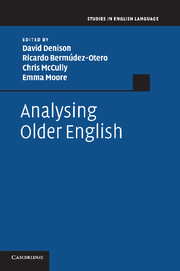Book contents
- Frontmatter
- Contents
- Figures and maps
- Tables
- Contributors
- General introduction
- Part I Metrics and onomastics in older English
- 1 Introduction to Part I
- 2 What explanatory metrics has to say about the history of English function words
- 3 to þære fulan flóde . óf þære fulan flode
- 4 Notes on some interfaces between place-name material and linguistic theory
- Part II Writing practices in older English
- Part III Dialects in older English
- Part IV Sound change in older English
- Part V Syntax in older English
- References
- Index
1 - Introduction to Part I
Published online by Cambridge University Press: 05 December 2011
- Frontmatter
- Contents
- Figures and maps
- Tables
- Contributors
- General introduction
- Part I Metrics and onomastics in older English
- 1 Introduction to Part I
- 2 What explanatory metrics has to say about the history of English function words
- 3 to þære fulan flóde . óf þære fulan flode
- 4 Notes on some interfaces between place-name material and linguistic theory
- Part II Writing practices in older English
- Part III Dialects in older English
- Part IV Sound change in older English
- Part V Syntax in older English
- References
- Index
Summary
The survival or non-survival into Middle English (ME) of those metrical principles constraining the classical Old English (OE) alliterative verse-line has been a particularly problematic area both for metrics and (in its role as theoretical explanandum-provider for metrics) for historical linguistics. Given the appearance of English thirteenth- and fourteenth-century poetic texts which are alliteratively constructed, and particularly texts written in dialect areas which might very loosely be termed ‘westerly’ (see below), it would seem logical to seek for metrical continuity between those principles obtaining in the alliterative verse familiar from OE of the ninth and tenth centuries and those obtaining in later ME poetic texts from the twelfth century through to the end of the fourteenth. On the other hand, given the apparent structural dissimilarities between classical OE alliterative verse (particularly that familiar from e.g. Beowulf) and later ME alliterative verse (particularly that familiar from e.g. Sir Gawain and the Green Knight (SGGK)), it also seems logical to seek an account of metrical discontinuity. Those working from the assumption or concept of ‘metrical continuity’ have included, for example, Oakden (1930) and Mossé (1968), while those working from the idea of at least partial discontinuity include Turville-Petre (1977) and Cable (1991). The latter scholars suggest, for example, that one source of ME alliterative verse might have been the prior existence of alliterative prose which in turn looked back to the influential aesthetic model provided by Ælfric. On this last view, the appearance of alliterative verse in later ME is not so much the continuity and modification of an old underlying Verse Design (to use Jakobson’s (1960) structuralist terminology) but the remodelling of a new Verse Design from an older prose tradition.
The matter is complicated in terms of verse history by the simultaneous appearance in the eleventh to thirteenth centuries of English verse which is (or becomes) more or less systematically rhymed; it is also complicated in terms of metrical dialectology by the persistence of alliterative forms of writing in parts of the south-west, the central-west and the north-west Midlands and in Scots (in the later fourteenth and early fifteenth centuries) but vanishingly rarely elsewhere – a form of interesting diatopic variation (McIntosh 1989a, 1989b).
- Type
- Chapter
- Information
- Analysing Older English , pp. 7 - 14Publisher: Cambridge University PressPrint publication year: 2011



